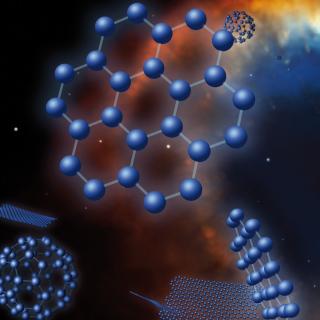Bibcode
Shaw, Richard A.; Lee, Ting-Hui; Stanghellini, Letizia; Davies, James E.; García-Hernández, D. A.; García-Lario, Pedro; Perea-Calderón, José V.; Villaver, Eva; Manchado, A.; Palen, Stacy; Balick, Bruce
Referencia bibliográfica
The Astrophysical Journal, Volume 717, Issue 1, pp. 562-576 (2010).
Fecha de publicación:
7
2010
Revista
Número de citas
33
Número de citas referidas
22
Descripción
We present an analysis of elemental abundances of He, N, O, Ne, S, and
Ar in Magellanic Cloud planetary nebulae (PNe) and focus initially on 14
PNe in the Small Magellanic Cloud (SMC). We derive the abundances from a
combination of deep, high-dispersion optical spectra, as well as
mid-infrared (IR) spectra from the Spitzer Space Telescope. A detailed
comparison with prior SMC PN studies shows that significant variations
in relative emission-line flux determinations among the authors, lead to
systematic discrepancies in derived elemental abundances between studies
that are gsim0.15 dex, in spite of similar analysis methods. We use
ionic abundances derived from IR emission lines, including those from
ionization stages not observable in the optical, to examine the accuracy
of some commonly used recipes for ionization correction factors (ICFs).
These ICFs, which were developed for ions observed in the optical and
ultraviolet, relate ionic abundances to total elemental abundances. We
find that most of these ICFs work very well even in the limit of
substantially sub-solar metallicities, except for PNe with very high
ionization. Our abundance analysis shows enhancements of He and N that
are predicted from prior dredge-up processes of the progenitors on the
asymptotic giant branch (AGB), as well as the well-known correlations
among O, Ne, S, and Ar that are little affected by nucleosynthesis in
this mass range. We identify MG 8 as an interesting limiting case of a
PN central star with a ≈3.5 M sun progenitor in which
hot-bottom burning did not occur in its prior AGB evolution. We find no
evidence for O depletion in the progenitor AGB stars via the O-N cycle,
which is consistent with predictions for lower-mass stars. We also find
low S/O ratios relative to SMC H II regions, with a deficit comparable
to what has been found for Galactic PNe. Finally, the elemental
abundances of one object, SMP-SMC 11, are more typical of SMC H II
regions, which raises some doubt about its classification as a PN.
Proyectos relacionados

Nucleosíntesis y procesos moleculares en los últimos estados de la evolución estelar
Las estrellas de masa baja e intermedia (M < 8 masas solares, Ms) representan la mayoría de estrellas en el Cosmos y terminan sus vidas en la Rama Asintótica de las Gigantes (AGB) - justo antes de formar Nebulosas Planetarias (NPs) - cuando experimentan procesos nucleosintéticos y moleculares complejos. Las estrellas AGB son importantes
Domingo Aníbal
García Hernández